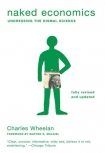Naked Economics, Wheelan, Charles [open ebook .txt] 📗

Book online «Naked Economics, Wheelan, Charles [open ebook .txt] 📗». Author Wheelan, Charles
Taxes can discourage investment, too. An entrepreneur who is considering making a risky investment may do so when the expected return is $100 million but not when the expected return, diminished by taxation, is only $60 million. An individual may pursue a graduate degree that will raise her income by 10 percent. But that same investment, which is costly in terms of tuition and time, may not be worthwhile if her after-tax income—what she actually sees after all those deductions on the paycheck—only goes up 5 percent. (On the day my younger brother got his first paycheck, he came home, opened the envelope, and then yelled, “Who the hell is FICA?”) Or consider a family that has a spare $1,000 and is deciding between buying a big-screen television and squirreling the money away in an investment fund. These two options have profoundly differently impacts on the economy in the long run. Choosing the investment makes capital available to firms that build plants, conduct research, train workers. These investments are the macro equivalents of a college education; they make us more productive in the long run and therefore richer. Buying the television, on the other hand, is current consumption. It makes us happy today but does nothing to make us richer tomorrow.
Yes, money spent on a television keeps workers employed at the television factory. But if the same money were invested, it would create jobs somewhere else, say for scientists in a laboratory or workers on a construction site, while also making us richer in the long run. Think about the college example. Sending students to college creates jobs for professors. Using the same money to buy fancy sports cars for high school graduates would create jobs for auto workers. The crucial difference between these scenarios is that a college education makes a young person more productive for the rest of his or her life; a sports car does not. Thus, college tuition is an investment; buying a sports car is consumption (though buying a car for work or business might be considered an investment).
So back to our family with a spare $1,000. What will they choose to do with it? Their decision will depend on the after-tax return the family can expect to earn by investing the money rather than spending it. The higher the tax, such as a capital gains tax, the lower the return on the investment—and therefore the more attractive the television becomes.
Taxation discourages both work and investment. Many economists argue that cutting taxes and rolling back regulation unleashes productive forces in the economy. This is true. The most ardent “supply-siders” argue further that tax cuts can actually raise the amount of revenue collected by the government because we all will work harder, earn higher incomes, and end up paying more in taxes even though tax rates have fallen. This is the idea behind the Laffer curve, which provided the intellectual underpinnings for the large Reagan-era tax cuts. Economist Arthur Laffer theorized in 1974 that high tax rates discourage so much work and investment that cutting taxes will earn the government more revenue, not less. (He first sketched a graph of this idea on a restaurant napkin while having dinner with a group of journalists and politicians. In one of life’s delicious ironies, it was Dick Cheney’s napkin.)13 At some level of taxation, this relationship must be true. If the personal income tax is 95 percent, for example, then no one is going to do a whole lot of work beyond what is necessary to subsist. Cutting the tax rate to 50 percent would almost certainly boost government revenues.
But would the same relationship hold true in the United States, where tax rates were much lower to begin with? Both the Reagan tax cuts and the George W. Bush tax cuts provided an answer: no. These large tax cuts did not boost government revenues (relative to what they would have been in the absence of the tax cut);* they led to large budget deficits. In the case of the Reagan tax cuts, Mr. Laffer’s conjecture did appear to hold true for the wealthiest Americans, who ended up sending more money to the Treasury after their tax rates were cut. Of course, this may be mere coincidence. As we shall explore in Chapter 6, highly skilled workers saw their wages rise sharply over the last several decades as the economy increasingly demanded more brains than brawn. Thus, the wealthiest Americans may have paid more in taxes because their incomes went up sharply, not because they were working harder in response to lower tax rates.
In the United States, where tax rates are low relative to the rest of the world, supply-side economics is a chimera: In all but unique circumstances, we cannot cut taxes and have more money to spend on government programs—a point that conservative economists readily concede. Bruce Bartlett, an official in both the Reagan and the George H. W. Bush administrations, has publicly lamented that the term “supply-side economics” has morphed from an important and defensible idea—that lower marginal tax rates stimulate economic activity—into the “implausible” notion “that all tax cuts raise revenue.”14 When Senator John McCain told the National Review in 2007 that tax cuts “as we all know, increase revenues,” Harvard economist Greg Mankiw (who served as chairman of the Council of Economic Advisers for George W. Bush) posed the logical follow-up question on his blog: “If you think tax cuts increase revenue, why advocate spending restraint? Can’t we pay for new spending programs with more tax cuts?”15 If I sound rather emphatic in making





Comments (0)